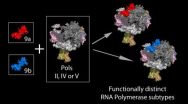Research led from the University of Leeds, has shown that the number of children and young adults in England with a 'life limiting condition'* is far higher than had previously been thought and is increasing year on year. As numbers continue to rise, this will place a growing burden on paediatric palliative care providers and young adult services, particularly in deprived areas.
The study, which is published in the journal Pediatrics, was a collaboration between the University of Leeds, Martin House Children's Hospice in Yorkshire, and the Children's Hospital, Cardiff. It was funded by the charity Together for Short Lives.
Experts agree that children who are born with or contract an illness that can shorten their life, and who may not reach adulthood, should have access to specialist palliative care. This can make an enormous difference to the quality of their life and to that of their family members.
Data on the use of children's hospice services is collected by Together for Short Lives. However, the total number of children who have received any form of specialist palliative care - or who might need it in the future - is not recorded nationally and local data is patchy. This has prompted concerns that health authorities may be underestimating the level of provision that is needed, leaving existing services under-resourced and overstretched.
To address this gap in knowledge, researchers took NHS data on children's admissions to hospitals in England from 2000 until 2010 and used an internationally recognised coding method to classify the medical conditions being treated. They found that for 2010, the prevalence of life limiting conditions in under-19s was 32 in 10,000 – exactly double the figure previously reported. From this, they estimate that there are about 40,000 children in England who are currently living with a life limiting condition.
The results showed a steady increase in the number of children living with a life limiting condition, particularly in the 16-19 age group. This suggests that the growing need for support associated with these conditions is being driven by longer survival times rather than a rise in the incidence of disease. The prevalence of life limiting conditions was also notably higher in some ethnic minority populations and areas of socio-economic deprivation.
University of Leeds researcher Dr Lorna Fraser, who led the study, said: "Children and teenagers with life limiting medical conditions will often need many years of specialist palliative care before they reach the end of their life, making it all the more important that their needs are not overlooked. Our study has confirmed doctors' suspicions and identified an escalating need for specialist paediatric care services. It is vital that health authorities now take this message on board and plan accordingly."
Dr Jan Aldridge, Consultant Clinical Psychologist at Martin House Children's Hospice, and one of the co-authors of the research, said: "Significant numbers of children with life-limiting conditions are living longer now, thanks to advances in medical care, but for many such children life gets harder as they get older. Statutory services are either non-existent or struggle to meet the needs of these older teenagers and young adults. At the moment, these children and their families place great value on the all-round support package provided by hospices such as Martin House, which help to address their medical, social and emotional needs. This model of specialist holistic care is one that health authorities and other services might draw upon."
Barbara Gelb, CEO of the UK children's palliative care charity, Together for Short Lives, added: "This study affords a real opportunity to better understand need and should help commissioners and service providers alike to better plan and deliver sustainable services when and where they are most needed. As the study shows, more young people with long term conditions are living longer; however we know that the specialist services they need are not meeting demand. Although there are some excellent services for young people; there are still major gaps in service provision and young people struggle to find appropriate care, housing, education and the work and social opportunities that they deserve."
INFORMATION:
Further information:
Contact: Paula Gould, University of Leeds Communications & Press Office: Tel +44 113 343 8059, email p.a.gould@leeds.ac.uk
* Life-limiting conditions (LLC) in children have been defined as conditions for which there is no reasonable hope of cure and from which children will die. Life-threatening conditions are those for which curative treatment may be feasible but can fail, such as cancer. In this study, LLC also included life-threatening conditions.
Notes to editors:
1. A copy of the paper [L Fraser et al. Rising National Prevalence of Life-Limiting Conditions in Children in England, Pediatrics 2012;129:1-7 (www.pediatrics.org/cgi/doi/10.1542/peds.2011-2846)] is available on request.
2. The UK Government's national strategy for children's palliative care, Better care, Better Lives was published in February 2008 (http://goo.gl/CLYF0).
3. The UK Department of Health is seeking to set up a new system for funding palliative care for adults and children. A pilot programme involving approximately ten organisations across the UK is expected to begin in April 2012 (http://goo.gl/gKIOE).
4. One of the UK's largest medical, health and bioscience research bases, the University of Leeds delivers world leading research in medical engineering, cancer, cardiovascular studies, epidemiology, molecular genetics, musculoskeletal medicine, dentistry, psychology and applied health. Treatments and initiatives developed in Leeds are transforming the lives of people worldwide with conditions such as diabetes, HIV, tuberculosis and malaria. www.leeds.ac.uk
5. Together for Short Lives is the only charity working across the UK to help ensure that every child and young person unlikely to reach adulthood, and their family, has the best possible care and support whenever and wherever they need it. As the UK voice for those children and young people unlikely to reach adulthood and their families, Together for Short Lives: Helps to ensure that families know about care and support available to them and give them a say in shaping the services they use; Defines and shares best practice to enable the highest standard of children's palliative care, in health, education and social care; Supports the development of sustainable children's palliative care services; Raises awareness of the needs of children, young people and their families requiring palliative care. For more information, visit www.togetherforshortlives.org.uk
Q&A
1. Is there any explanation as to why this report appears to indicate a specific increase in the overall numbers of life limiting and life threatening conditions? This appears contrary to earlier reports published by the charity ACT (2009) and the Department of Health (2007), although both documents suggested that there might be more children and young people with palliative care needs.
This is the first report to estimate the numbers children and young people with life limiting and life threatening conditions using national data on children who are currently alive. Previous reports have largely been based on death certificate data which is known to sometimes be incomplete eg if a child with severe cerebral palsy dies of pneumonia they may only have pneumonia coded on their death certificate. This would result in an underestimate of the number of children.
2. We understand that you have not identified a shortfall in current provision. So what are the implications of this study?
There may be a need for further specialist palliative care services, should this increase in prevalence continue. If the previous prevalence estimates of 16 per 10,000 are being used to plan services then there may be under-provision of services. Also the largest proportional rise in prevalence in this study was in the 16- to 19-year-olds who may require services for young adults which are currently lacking.
3. We note you have highlighted the significance of "deprivation" for children and young people with palliative care needs? Please can you tell us more about this? The prevalence of children and young people was highest in areas of high deprivation. This has been shown in previous studies of children with chronic disease but it is not clear whether the incidence of LLC is higher in deprived areas or whether the financial impact of having a child with a LLC can results in families moving to more deprived areas.
4. We note that you have identified a high number of neonates (babies less than 28 days old) requiring palliative care support and who have specific needs. Can you tell us more about this?
In this study, the prevalence of LLC was highest in the under-one age group. The highest prevalence of LLC was observed in children with life limiting congenital anomalies and these are often diagnosed at or soon after birth.
5. We note that you have used Hospital Episode Data to reach your conclusions. Such data and information varies across the UK. Is there any chance that your figures of LLC in children and young people may be over estimated?
We have used a robust method to identify children and young people with LLC. We have only included children who have a LLC coded in their hospital records. There is a chance we may have underestimated the prevalence as children were only counted if they had at least one hospital admission during the year.
END




